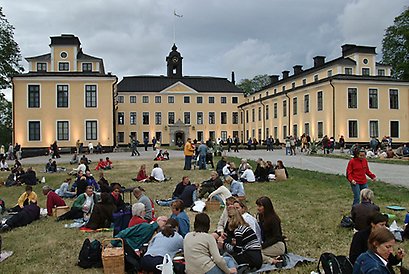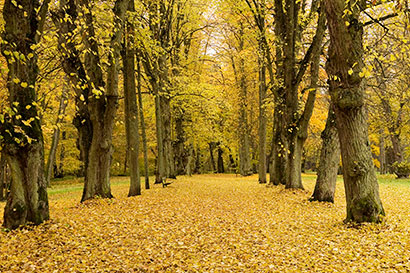Ulriksdal Palace Park
From the time that Jakob dela Gardie built a palace by Edsviken strand, some form of garden and park has also existed at Ulriksdal.
Different styles have replaced one another throughout the years, which means that the original park shares very few similarities with the park of today.
The parks and gardens at Ulriksdal are open all year long.
Late Renaissance
During Jakob de la Gardie's time of service to the palace 1638–1652 Renaissance gardens were often isolated entities with out any real ties to the palace buildings.
This was also true for Jakobsdal, which Ulriksdal was called at the time, where several smaller gardens with no direct connection to the palace were planted.
Hans Georg Kraus was contracted in 1647 to plant a palace garden. This contained a grotto, groves and a labyrinth to the left of the palace.
“Giardino Segreto"
Yet another garden “Giardino Segreto" was planted by the south wing of the palace. And finally a knot garden was planted below the pavilion mound in the north section of the park.
In addition to these more pleasure-oriented gardens, a more utility focused garden existed to the south of Igelbäcken.
Pre-baroque era
Magnus Gabriel de la Gardie served the palace from 1654–1669. At the same time as the palace was rebuilt at the beginning of the 1660s, the gardens were also changed.
De le Gardie himself was responsible for many of the basic ideas, helped by architect Jean de la Vallée.
At this time it was important to unite the gardens with the palace into one unit in the form of a large parterre divided into quarters. Ponds were dug and fountains were built. Sculptures were placed around the gardens.
Mons Mariae
A new pavilion was erected on the old pavilion mound and was called Mons Mariae after de la Gardie's wife Maria Euphrosyne. An orangery was built below the mound.
Even natural formations were incorporated into the park. For instance, a cliff on top of which a lead sculpture of Perseus was placed.
Perseus is pictured on his winged horse coming to save Andromeda who was captured by a three-headed monster. A sculpture of Andromeda was chained to the cliff wall and the monster was placed in a nearby pond.
Baroque
During Hedvig and Ulrika Eleonora's times from 1669–1741, baroque was characterised by quite strict symmetry which can be said to have marked the changes in the park.
The so called Queen's Avenue (north of Igelbäcken) was planted during this time in 1724.
Rococo – The Age of Liberty, 1741–1771
Carl Hårleman drew up a proposal at the beginning of the 1740s to reform the park. His plans were followed through to a large extent, bringing additional symmetry.
For instance, a narrow lime grove was planted facing the west directly north of the Queen's Avenue.
The Romantic Style Park, 1771–1810
During this period the park was considerably freer in character then previously, under the semblance of undisciplined nature.
Winding paths and a rolling billowing landscape were the height of fashion. Hermit dwellings (ideally containing a real hermit) and small Greek temples were the perfect finishing touches.
A romantic English park was established at the beginning of the 1800s to the west of the old palace gardens and 2000 wild trees were intermittently planted in the area.
Karl XV's era, 1850–1872
A cast iron fountain was placed in the courtyard and solitaire trees were planted in the parterres, many of which remain today.
In 1863 the sculpture “The Blackamoors dragging nets" was moved from Haga to Igelbäcken.
After Karl XV's death the most western part of the old Hårleman grove was cut down and many plants in the courtyard and the parterres were replanted.
Modern Classicism
While the palace was being put into order for the Crown Prince Gustaf (VI) Adolf and Crown Princess Louise, new plans were also drawn up for the park.
Landscape architect Gösta Reuterswärd was commissioned for this job in 1935.
The old parterre system was transformed into four large lawns with only two crossing paths, one from the centre axis of the castle and one from that of the orangery.
The round basins were replaced by a square with a powerful fountain jet.
Sculptures by Carl Milles
Two sculptures of wild boars by Carl Milles were placed by the fountain.
High stem lilac trees were planted along the centre axis of the park and lime avenues were planted after the fountain. Hawthorn trees were planted on the other transverse axis.
In conclusion it can be established that it would have been exciting if Magnus Gabriel de la Gardie's palace park had been preserved.
However, today's park is also a true gem, which many visitors have discovered in recent years.
Ulriksdal – part of the National City park
In 1996 King Carl XVI Gustaf officially opened Sweden's first National City Park, comprising North ans South of Djurgården, Ulriksdal Park, Haga Park and Brunnsviken. The Royal National City Park is Sweden's most-visited recreation area.
Photo: Dick Norberg

The park is home to several buildings dating from the 17th century through to 1860. The Ulriksdal guide book describes the buildings, and includes a map of the area. Photo: Gomer Swahn/Royalpalaces.se

The Blackamoors Pulling a Net sculptures were created by the artist Pehr Henrik Lundgren in 1845. They stand by the Igelbäcken stream in Ulriksdal Palace Park. Photo: Gomer Swahn/Royalpalaces.se

The park at Midsummer in 2009. The palace park is open to visitors all year round. Photo: Håkan Lind/Royalpalaces.se

The Orangery is an exhibition space for the National Museum's collection of Swedish sculpture. Photo: Gomer Swahn/Royalpalaces.se

The Queen's Avenue of lime trees at Ulriksdal Palace, one late evening just after Midsummer 2009. Photo: Håkan Lind/Royalpalaces.se

The Queen's Avenue of lime trees at Ulriksdal Palace, on a beautiful autumn day in late October 2009. Photo: Håkan Lind/Royalpalaces.se

A cast iron fountain was positioned in the courtyard and solitary trees were planted on the parterre – many of which still stand to this day. Photo: Håkan Lind/Royalpalaces.se

The park, with the Orangery Museum in the background. Here, works can be seen by some of the nation's leading sculptors including Carl Milles and Johan Tobias Sergel. Photo: Gomer Swahn/Royalpalaces.se










%20symbol.jpg)